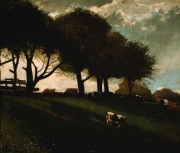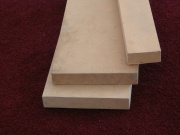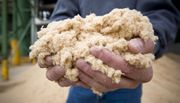Difference between revisions of "Fiberboard"
| Line 34: | Line 34: | ||
* Pam Hatchfield, ''Pollutants in the Museum Environment'', Archetype Press, London, 2002 | * Pam Hatchfield, ''Pollutants in the Museum Environment'', Archetype Press, London, 2002 | ||
| − | * ''Encyclopedia Britannica'', http://www.britannica.com Comment: "wood." | + | * ''Encyclopedia Britannica'', http://www.britannica.com Comment: "wood." E(Accessed 14 Mar. 2005). |
* Art and Architecture Thesaurus Online, http://www.getty.edu/research/tools/vocabulary/aat/, J. Paul Getty Trust, Los Angeles, 2000 | * Art and Architecture Thesaurus Online, http://www.getty.edu/research/tools/vocabulary/aat/, J. Paul Getty Trust, Los Angeles, 2000 | ||
Revision as of 09:59, 7 August 2020
Description
A rigid composite board of pressed cellulose fibers used as a building material. First patented in 1858, fiberboards were composed of wood chips or plant fibers, such as Grass, Reed, Straw, Bagasse (Celotex), Jute, Flax, or Hemp. Manufacturers have also recycled waste materials such as Sawdust, Bark, oat hulls, spent hops, newspaper (Homasote®) and peanut shells. The fibers are compressed and bonded with heat and pressure. Many fiberboards are held together by the interlocking fibers and natural adhesives (wet process); other fiberboards have additional adhesive components such as Urea formaldehyde resin, Water glass, Dextrin, Asphalt, Rosin, Paraffin wax, Plaster, and/or Clay. The standard size for fiberboards is 4 x 8 feet. Very dense fiberboard is called hardboard (see also Masonite®). Some commercially available formaldehyde-free fiberboards are Masonite® Presdwood®, Medex, Medite II and Iso-board (Hatchfield 2002). Fiberboards are generally classified as low-density (Celotex, etc.), medium-density (Medex, Medite, etc.), or high-density (Masonite®, Upson Board, Marinite®, Homasote®, etc.).
Synonyms and Related Terms
"fibre-board (Br.); fibreboard (Br.); carton-fibre (Fr.); carton fort (Fr.); aglomerado de madeira (Port.); particle board; composition board; wallboard; hardboard; fiber board; high-density fiberboard (HDF); medium-density fiberboard (MDF); low-density fiberboard (LDF)
Brand names: Masonite® [IPI]; Presdwood®; Medex; Medite; Duron® [IPI]; Upson; Homasote®; Insulite; Beaver Board; Cornell Board; Feltex; Fir-Tex; Nu-Wood; C-X Board; Quartrboard; Celotex;
Collection Risks
Any wood product may release organic acids with time.
Fiberboards are susceptible to dry rot, fungal growths and termites.
Links to Oddy Test results posted on AIC Wiki Materials Database Pages for individual materials below
- Newmarket MDF tested in 2006
- Newmarket MDF tested in 2006 with polyurethane coating
Resources and Citations
- C. Gould, K. Konrad, K. Milley, R. Gallagher, "Fiberboard", in Twentieth-Century Building Materials, T. Jester (ed.), McGraw-Hill: New York, 1995.
- G.S.Brady, Materials Handbook, McGraw-Hill Book Co., New York, 1971
- Dictionary of Building Preservation, Ward Bucher, ed., John Wiley & Sons, Inc., New York City, 1996
- Pam Hatchfield, Pollutants in the Museum Environment, Archetype Press, London, 2002
- Encyclopedia Britannica, http://www.britannica.com Comment: "wood." E(Accessed 14 Mar. 2005).
- Art and Architecture Thesaurus Online, http://www.getty.edu/research/tools/vocabulary/aat/, J. Paul Getty Trust, Los Angeles, 2000


